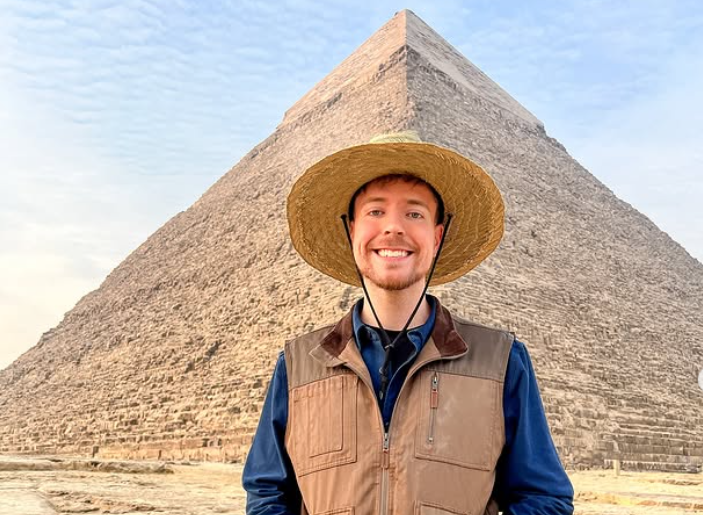Mrbeast Gets Unrestricted Access to Great Pyramids of Giza and People Are Shocked at What’s Inside

For over 4,500 years, the Great Pyramids of Giza have stood as silent sentinels of a lost civilization. They are more than just monuments; they are messages from the past, etched in stone, daring us to understand a world that no longer exists.
But while millions visit these ancient wonders each year, there are places inside them that have remained unseen—corridors and chambers where only a select few have ever walked. The kind of places that make you wonder: What else is hidden beneath these stones? What stories have been waiting to be told?
Enter MrBeast—the digital age’s most unlikely explorer. Known for his viral challenges and jaw-dropping philanthropy, he’s not the person you’d expect to find navigating the shadowy corridors of an ancient wonder. But when he was granted unrestricted access to one of the most heavily guarded historical sites in the world, the internet held its breath.
Because what he found inside? It left millions shocked.
The Forbidden Depths of the Great Pyramid
I got unrestricted access to explore the 3 Great Pyramids of Egypt for 100 hours.. Go watch the new video to see what we found 👀 pic.twitter.com/RTVhPurLw0
— MrBeast (@MrBeast) February 8, 2025
The Great Pyramid isn’t just a pile of ancient stones—it’s an engineering masterpiece, a puzzle of colossal precision, and a monument to a civilization that understood time in a way we still struggle to grasp. Every inch of its structure was built with purpose, from the towering limestone blocks to the hidden chambers buried deep within.
Most visitors only get to see a fraction of it. They walk through a single passageway, maybe peer into a chamber or two, then step back into the blinding Egyptian sun. But MrBeast? He wasn’t there for the tourist experience.
With cameras rolling and legendary Egyptologist Dr. Zahi Hawass leading the way, he stepped beyond the velvet ropes, into the unseen. Into history itself.
They descended through passageways that had been untouched by the public for generations. The air was thick with dust and the weight of thousands of years. Every step deeper into the pyramid felt like peeling back a layer of time, revealing secrets that had been buried for millennia.
And then, they reached it—the tomb of a pharaoh long forgotten by the world, but not by history.
Here, in the heart of the Great Pyramid, the walls were alive with hieroglyphs—stories carved in stone, meant to transcend death itself. The space was eerily quiet, as if the past itself was waiting to speak. This was a place designed for eternity, a resting place meant to secure a ruler’s passage into the afterlife.
But the deeper they went, the more mysteries unraveled.
Because beneath the Great Pyramid, hidden from view, was something even more astonishing: a submerged tomb linked to one of the most powerful legends in Egyptian mythology—the Tomb of Osiris.
The Submerged Tomb of Osiris: The ‘Portal to the Underworld’
Beneath the towering weight of history, past the winding corridors of the Great Pyramid, MrBeast and his team descended into a space few have ever seen. This was no ordinary chamber. The deeper they went, the cooler the air became, thick with the scent of ancient stone and damp earth. The echoes of their footsteps faded into a silence that had stretched across millennia.
Then, they saw it.
A deep pit, carved into the bedrock, filled with still, black water. And at its center—a massive granite sarcophagus, half-submerged, resting in eerie isolation.
This was the Tomb of Osiris. A place wrapped in legend, its origins buried beneath layers of myth and time.
Ancient Egyptians believed Osiris was the god of the underworld, the ruler of life after death. His tomb, they said, was no ordinary burial site—it was a gateway to the afterlife, a threshold between worlds. For centuries, scholars, adventurers, and dreamers alike had speculated about its secrets. Was something hidden beneath the water? Was this truly the final resting place of a divine king?
MrBeast stood at the edge, looking into the darkness below. The weight of history pressed in. What lay beyond that water had been untouched for ages—untouched by modern hands, untouched even by time itself.
Dr. Zahi Hawass, ever the voice of reason, stepped forward to unravel the mystery. He explained that while this chamber was not Osiris’s literal tomb, its design carried a sacred purpose. The water, the sarcophagus, the chamber itself—they were meant to reflect the mythology, a symbolic recreation of Osiris’s eternal resting place.
Even so, the sight was haunting. The sarcophagus, untouched and ancient, seemed to hold secrets beyond what any camera could capture. The still water surrounding it felt like a boundary—not just physical, but spiritual.
For the millions watching, this wasn’t just another YouTube video. It was a moment where history and myth stood side by side, where the past felt dangerously close to the present.
The Power of Exploration: Bringing the Past to the Present
The Great Pyramid has watched over the Earth for more than 4,500 years. Through wars, revolutions, and the rise and fall of entire civilizations, it has stood—unchanging, unshaken, a monument to time itself.
But history is not meant to be locked away. It is meant to be explored, understood, and passed on. That’s what made this journey different. MrBeast didn’t just step inside an ancient wonder—he brought millions of people with him.
For years, the mysteries of the pyramids have been buried beneath layers of myth and speculation. But in a world dominated by fleeting content and short attention spans, this was a rare moment where history wasn’t just told—it was felt. The dark passageways, the submerged tomb, the towering stones—they weren’t distant relics anymore. They were real. Tangible. Alive.
And that is the true power of exploration.
Because history isn’t just a subject in school. It’s a story we are still writing.
For the teenager watching from their bedroom, this might have been the first time they saw history as something more than words in a textbook. For the traveler who has always dreamed of visiting Egypt, this was a glimpse into a world few have ever seen. And for those who have always questioned how or why these structures exist, this was a reminder that curiosity itself is a bridge—one that connects the past with the present.
But curiosity alone isn’t enough.
Dr. Zahi Hawass, who has spent his life protecting Egypt’s ancient wonders, made something clear: these sites are not entertainment props. They are sacred. They are the legacy of a civilization that understood something we often forget—that time is fleeting, but the stories we leave behind matter.
Exploration is a gift, but it comes with a responsibility. It is not just about uncovering secrets—it is about respecting them. It is about ensuring that what we learn is not just consumed but preserved, that the wonders of the past are not just seen, but honored.
Because history is not ours to exploit. It is ours to protect.
What’s Left to Discover?
 Image Source: Shutterstock
Image Source: Shutterstock
For all that has been uncovered—the hidden tombs, the submerged mysteries, the architectural brilliance—the Great Pyramid is still holding onto its deepest secrets. Scans have revealed uncharted voids and passageways, spaces yet to be explored, hinting that history may still have more to say. The answers? They remain locked within stone, waiting for those bold enough to seek them.
But the greatest discovery isn’t just inside the pyramids—it’s inside us. This journey wasn’t just about ancient wonders; it was about curiosity, about breaking past the barriers of what we think we know. It was a reminder that history isn’t just something we study—it’s something we experience, something that shapes us as much as we shape it.
MrBeast’s exploration pulled back the curtain on a world most will never see, but the real impact isn’t in the views—it’s in the minds it has sparked. Because the past isn’t just a story—it’s a mirror. And the biggest question of all? What will we leave behind for those who come after us?
The Past Still Speaks—Are We Listening?
The Great Pyramid is more than an ancient wonder—it is a testament to human ambition, to a civilization that sought to defy time itself. In stepping beyond the barriers and into history’s most guarded corridors, MrBeast didn’t just reveal hidden tombs or ancient myths—he reignited curiosity. He reminded millions that the past is not dead; it is waiting for those who are willing to seek, to learn, and to listen.
But exploration is not just about uncovering secrets—it’s about honoring them. The stones of the pyramids have withstood the weight of centuries, but they are not invincible. What we discover must be met with the same reverence as those who built them, ensuring that history is not just consumed—but preserved for generations to come.
Because in the end, the pyramids stand as more than monuments. They are messages. Messages from a civilization that understood that what we create, what we build, and what we leave behind will one day tell our story. The question is, what story are we writing?
Featured Image Source: MrBeast on Instagram
Loading...
Related Content
 When Science Shows Our Bones Can Rise Again
When Science Shows Our Bones Can Rise AgainBy Prince Ea





